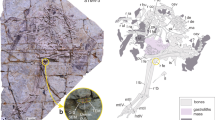Summary
The structure and distribution of hyaline-cell cartilage (chondroid) (HCC) in the heads of teleosts has been studied in 48 species from 16 families. The tissue is palestaining and has closely-packed, hyaline cells that are separated by a small quantity of matrix. The matrix has only a mild affinity for alcian blue and the cells are not shrunken within lacunae. Two subtypes of the tissue are here described — fibrohyaline-cell cartilage (chondroid) where collagen fibres are prominent in the matrix, and lipohyaline-cell cartilage where fat and hyaline cells are intermingled. An elastic hyaline-cell cartilage has been described previously. Associations of HCC with dense fibrous connectivet tissue, mucochondroid, hyaline cartilage and bone are described. Lists are provided of membrane and cartilages bones to which the tissue is attached and of species in which it is common. Suitable ‘type examples’ for reference and for further study include the cartilage in the rostral folds of the red-tailed black shark, Labeo bicolor and the flying for, Epalzeorhynchus kalopterus.
HCC occurs in lips and rostral folds, in pre-palatine and submaxillary menisci, in ligaments, at the anterior end of the basihyal, in the pectoral girdle, in adhesive discs, in gill arches, beneath the basioccipital chewing pad, in barbels, next to the facial nerve, around the olfactory region and in the core of the nasal skin flaps. It is a particularly important tissue in cyprinids and related fish, and enormous masses of it are present in the black shark, Morulius chrysophekadion and the Hong Kong pleco, Pseudogastromyzon myersi. It acts as a damper against the contractions of the heart or the pressure of occluding pharyngeal teeth, and it provides the mouth region of bottom-dwelling, algal eaters with flexible support. In relation to Schaffer's classification of supporting tissues, I confirm a distinction between HCC and Zellknorpel.
Similar content being viewed by others
References
Bargmann W (1973) Zur Histologie der Saugplatte des Schiffshalters Echeneis naucrates L. Z Zellforsch 139:149–170
Benjamin M (1986) The oral sucker of Gyrinocheilus aymonieri (Teleostei: Cypriniformes). J Zool (Lond) 1B:211–254
Benjamin M (1988a) Mucochondroid (mucous connective) tissues in the heads of teleosts. Anat Embryol 178:461–474
Benjamin M (1988b) Secondary cartilage in teleosts. J Anat (Lond) 158:220
Benjamin M (1988c) The development of hyaline cell cartilage in the head of the black molly, Poecilia sphenops — Evidence for secondary cartilage in a teleost. J Anat (Lond) (in press)
Benjamin M, Sandhu JS (1987) A highly cellular cartilage in teleosts. J Anat (Lond) 152:251–252
Beresford WA (1989) Cranial skeletal tissues: diversity and phylogenetic trends. In: Hanken J, Hall BK (eds) The vertebrate skull vol II. Patterns of structural and systematic diversity. University of Chicago Press, Chicago (in press)
Bertin L (1958) Tissus squelettiques. In: Grassé PP (ed) Traité de Zoologie 13 (Fasc 1):532–550. Masson, Paris
Blanc M (1953) Contribution à l'étude de l'osteogenese chez les poissons téléostéens. Mémoires du Museum National d'Histoire Naturelle 7A:1–146
Eaton TH (1935) Evolution of the upper jaw mechanism of teleost fish. J Morphol 58:157–189
Gabe M (1967) Cartilage, tissu osseux et ostéogenèse. In: Traité de Zoologie 16 (1):235–333
Girgis S (1952) On the anatomy and histology of the alimentary tract of an herbiverous bottom-feeding cyprinoid fish, Labeo horie (Vuvier). J Morphol 90:317–362
Gosline WA (1977) The structure and function of the dermal pectoral girdle in bony fishes with particular reference to ostariophysines. J Zool (Lond) 183:329–338
Gross RJ (1954) The role of the central cartilagious rod in the regeneration of the catfish taste barbel. J Exp Zool 127:181–199
Joyce EC, Chapman GB (1978) Fine structure of the nasal barbel of the channel catfish Ictalurus punctatus. J Morphol 158:109–114
Laguesse ME (1892) Bourrelets valvulaires artériels chez les poissons (Labrus, crenilabrus). Compt Rend Soc Biol (Paris) 44:211–213
Liem KF (1967) Functional morphology of the head of the anabantoid teleost fish Helostoma temmincki. J Morphol 121:135–158
Lœwenthal N (1924) Sur le tissue fibro-hyalin et les bourrelets périostiques des poissons. Bull d'Histol Appliquee 1:529–549
Lubosch W (1938) Vergleichende mikroskopische Anatomie der Organe des Skelettsystems. A. Die permanenten knorpeligen Skeletteile. In: Handbuch der vergleichenden Anatomie der Wirbeltiere 5:249–274. Urban and Schwarzenberg, Berlin Wien
Minzenmay A (1933) Die Mundregion der Cypriniden. Zool Jahrb 57:191–286
Moss ML, Moss-Salentijn L (1983) Vertebrate cartilages. In: Hall BK (ed) Cartilage vol 1, 1–30. Academic Press, New York London
Person P (1983) Invertebrate cartilages. In: Hall BK (ed) Cartilage vol 1, 31–57. Academic Press, New York London
Rauther M (1928) Der Saugmund von Discognathus. Zool Jahrb 45:45–76
Saxena S, Chandy M (1966) Adhesive apparatus in certain Indian hill stream fishes. J Zool (Lond) 148:315–340
Schaffer J (1930) Die Stützgewebe. In: Möllendorff W von (ed) Handbuch der mikroskopischen Anatomie des Menschen 2: Die Gewebe, part 2:1–390, Springer, Berlin
Stüdnička FK (1903) Histologische und histogenetische Untersuchungen über das Knorpel-, Vorknorpel- und Chordagewebe. Anat Hefte 1. 21:280–525
Weisel GF (1960) The osteocranium of the catostomid fish, Catostomus macrocheilus. A study in adaptation and natural relationship. J Morphol 106:109–129
Wurmbach H (1932) Das Wachstum des Selachierwirbels und seiner Gewebe. Zool Jahrb 55:1–136
Author information
Authors and Affiliations
Rights and permissions
About this article
Cite this article
Benjamin, M. Hyaline-cell cartilage (chondroid) in the heads of teleosts. Anat Embryol 179, 285–303 (1989). https://doi.org/10.1007/BF00326593
Accepted:
Issue Date:
DOI: https://doi.org/10.1007/BF00326593




